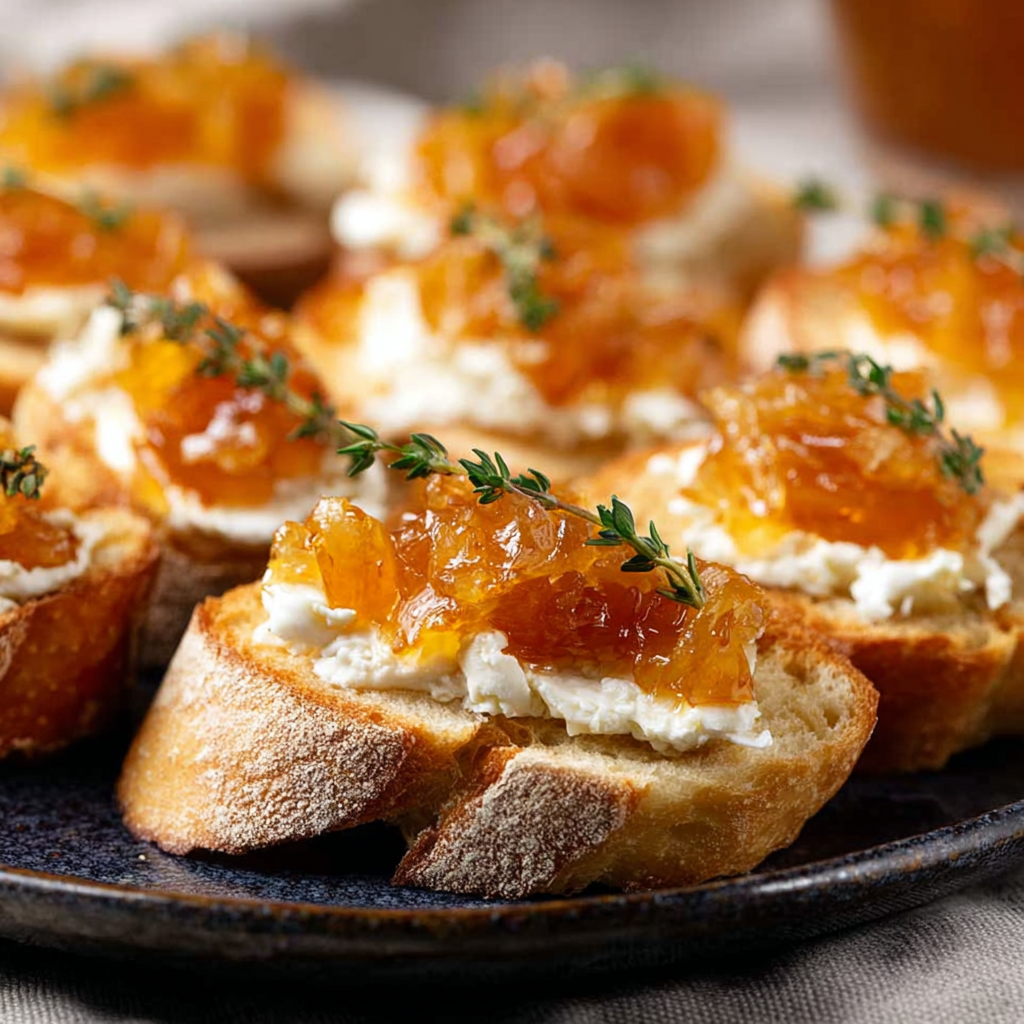1. Introduction to the Recipe
There are few appetizers as elegant, irresistible, and surprisingly simple as Apricot, Goat Cheese & Caramelized Onion Crostini. With its perfect balance of sweet apricot preserves, tangy goat cheese, and deeply savory caramelized onions, this recipe elevates even the most casual gathering into something memorable. Whether you’re hosting a holiday party, preparing a romantic dinner, or simply looking for a snack that tastes like it came from a gourmet wine bar, these crostini deliver sophistication without the fuss. The contrasting flavors and textures—crispy toasted baguette, creamy cheese, glossy preserves, and jammy onions—create an experience that feels indulgent, warm, and comforting all at once.
What makes this appetizer especially appealing is its versatility. You can serve it warm, room temperature, or even chilled, making it perfect for entertaining when timing is unpredictable. The combination of ingredients also allows for endless variations depending on your taste preferences or the seasonal produce available. If you’re new to the world of crostini, you’ll find this recipe incredibly approachable, while seasoned hosts will appreciate that it can be assembled ahead of time with ease. For readers interested in deepening their ingredient knowledge, you can explore more on caramelizing onions here or learn about selecting and storing fresh herbs like thyme here.
Most importantly, this recipe takes a few simple ingredients and transforms them into something far greater than the sum of their parts. The Apricot, Goat Cheese & Caramelized Onion Crostini is more than just a bite-sized treat—it’s a celebration of flavor harmony, making it ideal for both casual cooks and food enthusiasts seeking a standout appetizer. With its polished presentation and minimal effort, this recipe deserves a treasured spot in your entertaining repertoire.
2. Basic Recipe: Ingredients and Instructions
Print
Apricot, Goat Cheese & Caramelized Onion Crostini Recipe
Description
Easy Apricot, Goat Cheese & Caramelized Onion Crostini combines sweet, tangy, and savory flavors for the perfect appetizer or party bite.
Ingredients
- ½ loaf baguette
- 2 tablespoons vegetable oil
- 1 large sweet onion, peeled and thinly sliced
- ½ teaspoon salt
- ½ teaspoon granulated sugar
- ⅔ cup apricot preserves
- 4 ounces goat cheese, crumbled
- Fresh thyme, for garnish
Instructions
- Prepare the Crostini Base:
Preheat your oven to 375°F (190°C). Slice the baguette into ½-inch rounds and arrange them on a baking sheet. Lightly brush each slice with vegetable oil. Bake for 7–10 minutes, or until lightly golden and crisp. - Caramelize the Onions:
In a large skillet over medium heat, warm the remaining oil. Add the sliced onion, salt, and sugar. Cook slowly, stirring every few minutes, until the onions turn deep golden and soft—about 25–30 minutes. - Assemble the Crostini:
Spread a thin layer of apricot preserves on each toasted baguette slice. Add a small amount of caramelized onion on top, followed by crumbled goat cheese. - Finish with Fresh Herbs:
Garnish each crostini with a few thyme leaves. Serve immediately or at room temperature.
Notes
For deeper onion flavor, deglaze the pan with a splash of white wine or balsamic vinegar.
If serving later, keep toasted baguette slices separate from toppings to preserve crispness.
Warm the goat cheese slightly for easier crumbling and smoother texture.
3. Advanced Techniques
1. Mastering Deep Caramelization for Maximum Flavor
Deep caramelization is one of the key elements that defines the Apricot, Goat Cheese & Caramelized Onion Crostini. To elevate this process, allow the onions to cook for up to 45 minutes, adjusting the heat as needed to avoid burning. The slower the caramelization, the richer and more jam-like the onions become. Adding a tablespoon of water at intervals prevents sticking and encourages even browning. Another trick is incorporating a small splash of white wine, sherry, or balsamic vinegar at the end to add acidity and depth. This transforms simple onions into a luxurious topping that enhances the sweetness of the apricot preserves while balancing the tangy goat cheese for a perfectly layered flavor profile.
2. Enhancing Bread Texture Through Dual Toasting
Bread texture is essential to well-crafted crostini. To achieve a truly professional finish, use a dual-toasting technique. First, lightly dry-toast the baguette slices in the oven without oil for a few minutes. Then, brush them with oil and toast again until crisp. This two-step process ensures the slices develop a firm base that stays crunchy even under moist toppings. For added flavor, brush with garlic-infused oil or sprinkle lightly with herbs like thyme or rosemary. A robust crostini base is especially crucial when serving at parties, where they may sit out longer and need to maintain structure.
3. Infusing Goat Cheese with Complementary Flavors
While goat cheese is delicious on its own, you can heighten its presence by infusing it with complementary flavors. Mix the cheese with a teaspoon of honey, a pinch of black pepper, or a swirl of fresh herbs such as thyme or tarragon. You can also whip the goat cheese with a tablespoon of cream or Greek yogurt for a lighter, more spreadable texture. This technique helps the cheese meld with the apricot preserves and onions in an even more harmonious way. Infused cheese especially benefits those who prefer a softer and more luxurious mouthfeel.
4. Creating a Layered Apricot Spread
Instead of using apricot preserves straight from the jar, take a moment to enhance them. Simmer the preserves briefly with a squeeze of lemon juice, a pinch of salt, or even a splash of bourbon for a smoky warmth. As the mixture warms, it becomes easier to spread and takes on added complexity. Adding finely diced dried apricots creates additional texture and boosts the fruitiness. This upgraded spread adds brightness that complements the caramelized onion’s depth and the goat cheese’s tang.
5. Perfecting Presentation with Micro Herbs and Finishing Oils
A beautifully garnished crostini is as pleasurable to the eyes as it is to the palate. Beyond basic thyme sprigs, consider using microgreens like micro basil or micro thyme for a delicate, refined look. A light drizzle of high-quality finishing oil—such as walnut oil, roasted hazelnut oil, or even a mild truffle oil—can take the entire dish to gourmet status. These finishing touches amplify both aroma and flavor, making each bite feel refined and well-composed.

4. Storage, Shelf Life, and Maintenance Tips
1. Storing Crostini Bases for Extended Freshness
To preserve baked crostini slices, allow them to cool completely and store in an airtight container. They keep their crispness for up to three days at room temperature. For longer storage, freeze the slices in a zip-top bag. When ready to use, warm them in the oven for 4–5 minutes to restore crunch. Keeping the bases separate from toppings ensures the texture stays perfect and prevents sogginess from moisture-rich ingredients.
2. Refrigerating Toppings Separately for Optimal Quality
The key to maintaining the appeal of Apricot, Goat Cheese & Caramelized Onion Crostini lies in separating the components when storing. Caramelized onions should be stored in a sealed container and refrigerated for up to five days. Apricot preserves will last for weeks, and goat cheese stays fresh for about a week once opened. If storing all three components together, keep each in a separate airtight compartment to preserve texture and flavor.
3. Freezing Caramelized Onions for Long-Term Use
Caramelized onions freeze exceptionally well and reheat beautifully, making them perfect for batch preparation. Spread them into a thin layer on a parchment-lined sheet and freeze before transferring to a container. This method prevents clumping and allows you to scoop small portions as needed. When reheated gently in a skillet, they return to their velvety, sweet consistency, ideal for assembling fresh crostini anytime with minimal prep.
4. Preventing Soggy Crostini During Parties
To keep crostini crisp during gatherings, assemble them close to serving time or use a barrier ingredient. For example, spread the goat cheese first, as its creamy consistency prevents moisture from the preserves and onions from absorbing into the bread. You may also lightly brush the crostini with melted butter before toasting; the fat forms a shield that keeps the bread firm even after sitting out.
5. Reviving Leftover Crostini
If crostini soften after storage, simply toast them again at 350°F for 3–5 minutes. This technique works for both plain and lightly topped slices, though for heavily topped crostini it is better to refresh each component separately. Rewhipping the goat cheese or gently reheating the onions helps restore texture, ensuring leftovers taste as vibrant as freshly made servings.

5. Dietary Adaptations and Substitutions
1. Creating a Vegan Version
To adapt Apricot, Goat Cheese & Caramelized Onion Crostini for a vegan diet, replace goat cheese with plant-based alternatives. Vegan feta or cashew-based cheese spreads work wonderfully for achieving a tangy, creamy texture. Use olive oil instead of vegetable oil for richer flavor when caramelizing onions. Also ensure your apricot preserves contain no gelatin or honey (most do not). With these adjustments, the flavor balance remains beautifully sweet, savory, and satisfying.
2. Gluten-Free Crostini Options
Swap the baguette for gluten-free alternatives such as rice-flour baguettes or seeded gluten-free crackers. Toast these gently to mimic the crispness of traditional bread. Some gluten-free breads absorb oil more quickly, so reduce brush-on oil by half to avoid heaviness. This adaptation ensures the appetizer stays accessible without sacrificing crunch or flavor.
3. Low-Sugar Modifications
For those reducing sugar, use unsweetened apricot spread or blend fresh apricots into a thick puree. Reduce the sugar added during caramelization or omit it entirely. Sweet onions naturally caramelize beautifully with slow cooking alone. The result is a more naturally sweet crostini with fewer added sugars but full flavor.
4. Nut-Free Adaptation
This recipe is naturally nut-free, but if you are serving guests with allergies, be mindful of cross-contamination. Avoid oils processed in facilities that handle nuts. Stick with simple, safe oils like pure olive or vegetable oil, and confirm that store-bought preserves contain no nut-derived additives.
5. Lower-Fat and Light Versions
To reduce fat content, replace goat cheese with low-fat soft cheese or part-skim ricotta blended with lemon zest for brightness. You can also lightly brush the crostini with broth instead of oil before toasting. While the texture changes slightly, the crostini still deliver excellent flavor with significantly fewer calories.

6. FAQs About the Recipe
1. Can I Make the Crostini Ahead of Time?
Yes, but for best texture, keep the components separate until serving time. Toast the baguette slices up to three days ahead and store in an airtight container. Caramelized onions can be refrigerated or frozen. Assemble the crostini no more than 30 minutes before serving to keep the bread crisp and toppings fresh. This strategy makes hosting seamless.
2. What Can I Use Instead of Goat Cheese?
Many cheeses work well. Cream cheese provides a mild, creamy base; ricotta offers lightness; and blue cheese creates a bolder, more complex flavor. Non-dairy cheeses also work when softened or whipped. The key is choosing a cheese that contrasts nicely with the sweet apricot spread and onions.
3. Why Did My Crostini Turn Out Soggy?
Sogginess typically occurs when moisture-rich toppings sit on the bread too long. Make sure to toast the baguette thoroughly on both sides, assemble just before serving, or add the cheese layer first to act as a barrier. Avoid placing hot onions on the bread unless serving immediately.
4. Can I Use Another Type of Preserves?
Absolutely. Fig, peach, cherry, and pear preserves make excellent substitutions. Each will impart a different personality to the crostini. Consider pairing preserves with alternative cheeses or herbs to complement their unique flavors.
5. How Do I Keep Goat Cheese from Crumbling Too Much?
Chilling goat cheese makes it firmer and more likely to crumble. For smoother application, let it come to room temperature. You can also whip it with a teaspoon of cream or olive oil for a spreadable consistency.

7. Conclusion & Final Thoughts
The Apricot, Goat Cheese & Caramelized Onion Crostini truly stands out as a sophisticated yet effortless appetizer that brings elegance to any table. Its combination of sweet, savory, tangy, and aromatic elements captures everything we love about well-balanced, thoughtfully crafted finger foods. Whether you’re preparing for a holiday gathering, a wine-tasting night, or simply elevating a weekday meal, this recipe delivers exceptional flavor with minimal work. It showcases how a few simple ingredients—when treated with proper technique—can transform into something remarkable and memorable.
One of the greatest strengths of this crostini is its versatility. It works beautifully with customizations, dietary substitutions, and flavor enhancements, making it a dependable go-to for a wide range of occasions. The ability to prepare its components ahead of time makes entertaining less stressful, while still allowing you to serve something that feels special. Between the crispy toasted baguette, the silky caramelized onions, the creamy goat cheese, and the bright apricot layer, every bite feels considered and complete.
Whether you’re an experienced cook or a beginner eager to explore gourmet-style appetizers, this recipe offers an accessible entry point into elevated cooking. It’s perfect for celebrations, potlucks, intimate dinners, or anytime you want to share something delicious and beautiful. By mastering a few simple techniques—deep caramelization, thoughtful layering, and careful presentation—you can create crostini that rival restaurant-quality creations. This dish is more than just an appetizer; it’s proof that simple ingredients, when combined thoughtfully, can create extraordinary culinary moments worth savoring and sharing.
